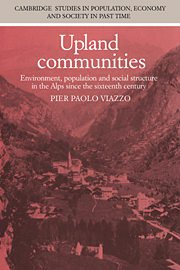 Upland Communities
Upland Communities Book contents
- Frontmatter
- Contents
- List of illustrations
- List of tables
- List of abbreviations
- Acknowledgements
- Introduction: anthropology, historical demography and the study of mountain societies
- 1 Environment, population and social structure: the Alpine village as an ecosystem
- 2 Open systems, open questions
- 3 Anthropologists in the Alps
- 4 The changing demography of Alpine communities
- 5 The traditional economy and its demise
- 6 The causes and consequences of Alpine emigration
- 7 The wealth from the earth: mining and immigration
- 8 Population, resources and homeostatic regulation
- 9 The domestic domain
- 10 Upland communities
- A summary of conclusions
- Bibliography
- Index
4 - The changing demography of Alpine communities
Published online by Cambridge University Press: 13 October 2009
- Frontmatter
- Contents
- List of illustrations
- List of tables
- List of abbreviations
- Acknowledgements
- Introduction: anthropology, historical demography and the study of mountain societies
- 1 Environment, population and social structure: the Alpine village as an ecosystem
- 2 Open systems, open questions
- 3 Anthropologists in the Alps
- 4 The changing demography of Alpine communities
- 5 The traditional economy and its demise
- 6 The causes and consequences of Alpine emigration
- 7 The wealth from the earth: mining and immigration
- 8 Population, resources and homeostatic regulation
- 9 The domestic domain
- 10 Upland communities
- A summary of conclusions
- Bibliography
- Index
Summary
‘Traditional’ communities and tourist resorts
Most of what we know about contemporary population trends in the Alps comes from studies that geographers, and some economists, began to pursue in the late 1950s in the attempt to better understand a process of economic and demographic transformation which was rapidly taking imposing dimensions. Both these earlier studies and the subsequent literature are largely based on post-war census data, which have been used to work out helpful and at times sophisticated typologies. Different authors have relied on different classificatory and analytical criteria. Some have started from variations in the occupational structure, others have subdivided Alpine communities according to their rates of population growth or their altitude. On the whole, however, all these studies have proposed a sequence of types ranging from ‘traditional’ communities, where agriculture is still of primary significance and population is sharply declining, to the demographically much healthier tourist resorts, where increasing proportions of the inhabitants are engaged in service industries.
The striking contrast between these two extreme types of Alpine community was made almost brutally evident to me when, in the first months of my field research, I began to realize how different the situation of Alagna was from that of Rima and Rimella, the two other Walser colonies in the Sesia Valley. Rima, which had been a small village since its beginnings, was now completely abandoned during the winter and was inhabited by no more than a handful of people during the summer.
- Type
- Chapter
- Information
- Upland CommunitiesEnvironment, Population and Social Structure in the Alps since the Sixteenth Century, pp. 67 - 99Publisher: Cambridge University PressPrint publication year: 1989
